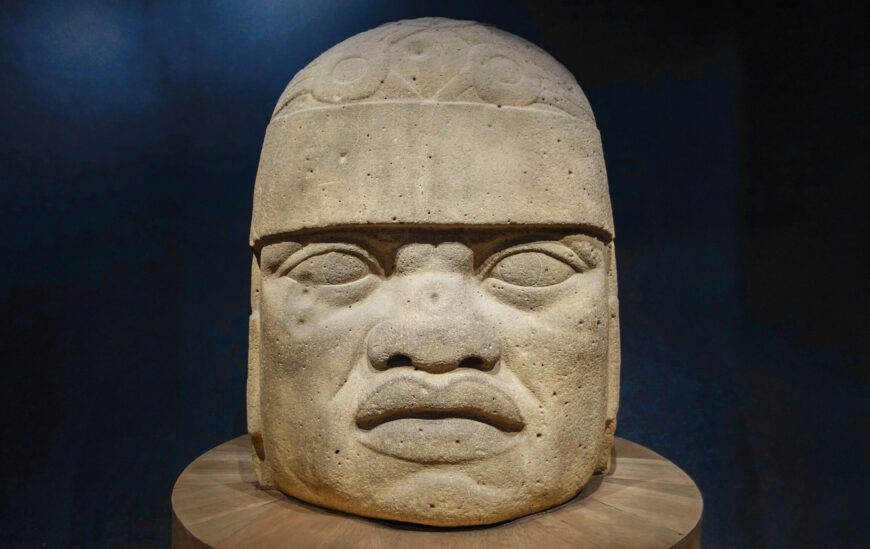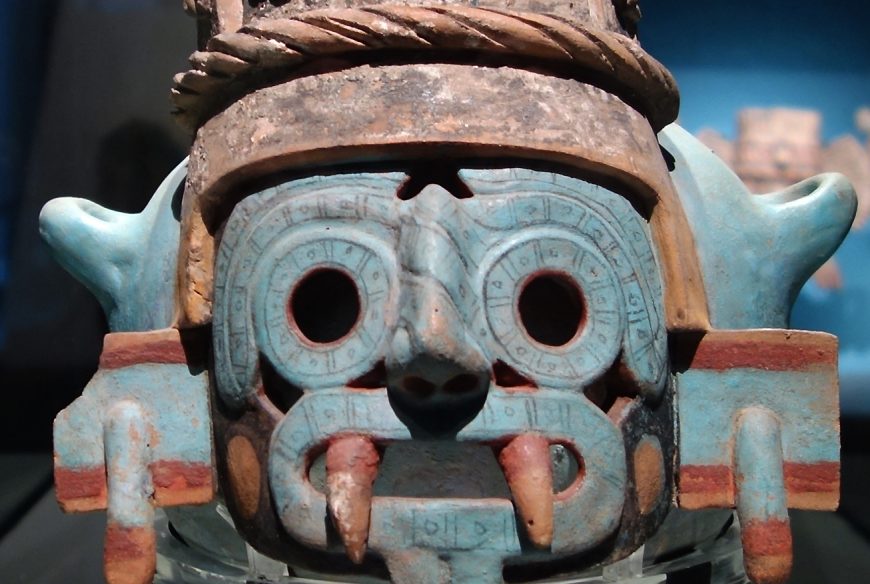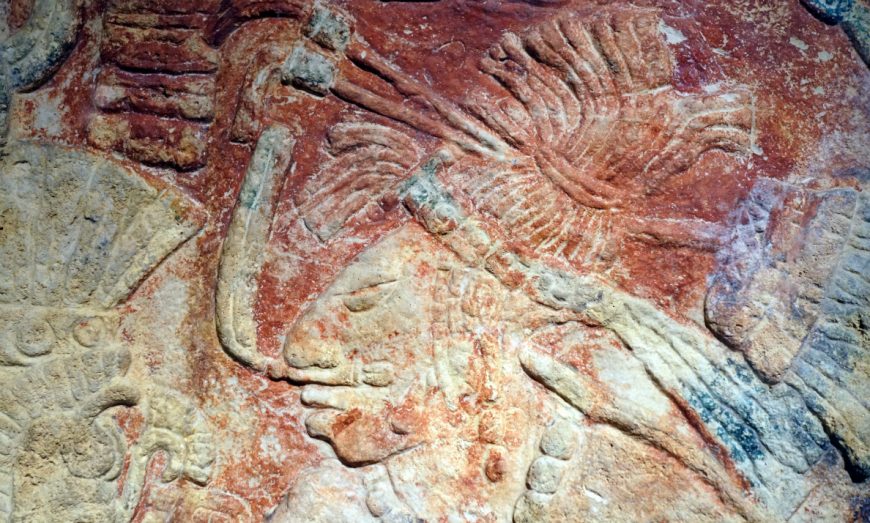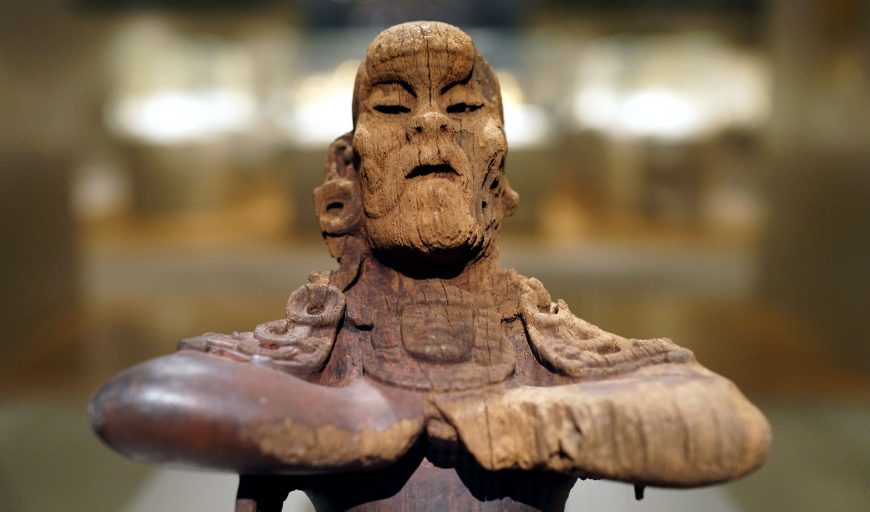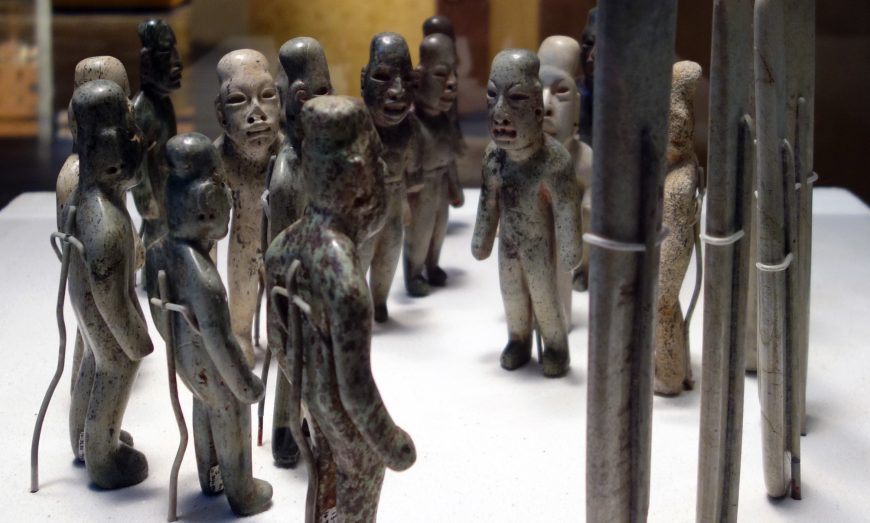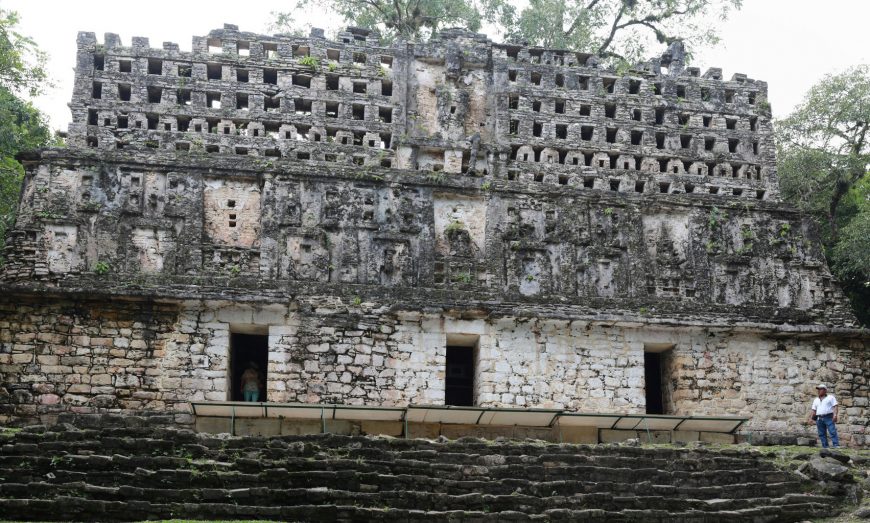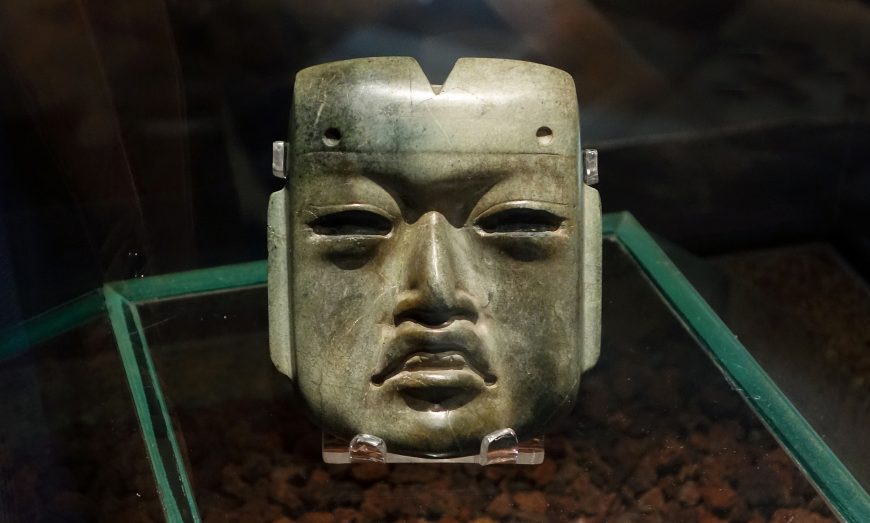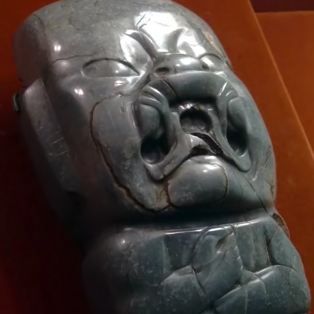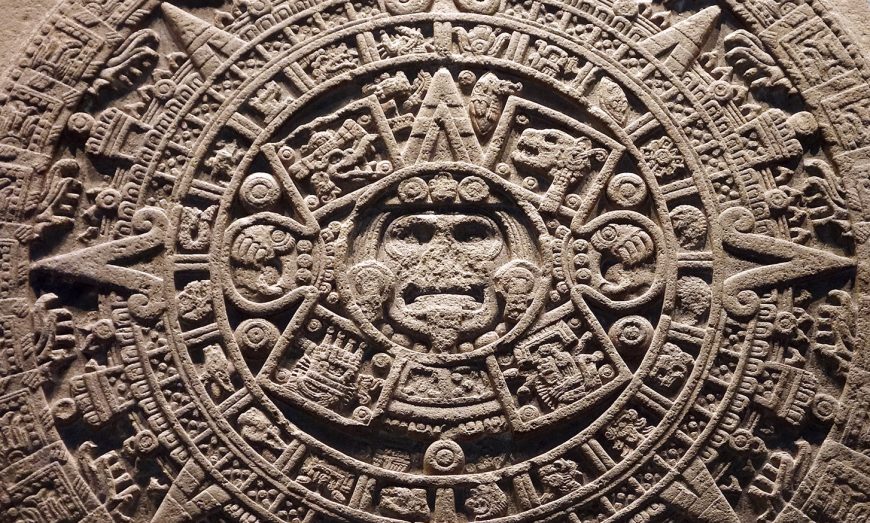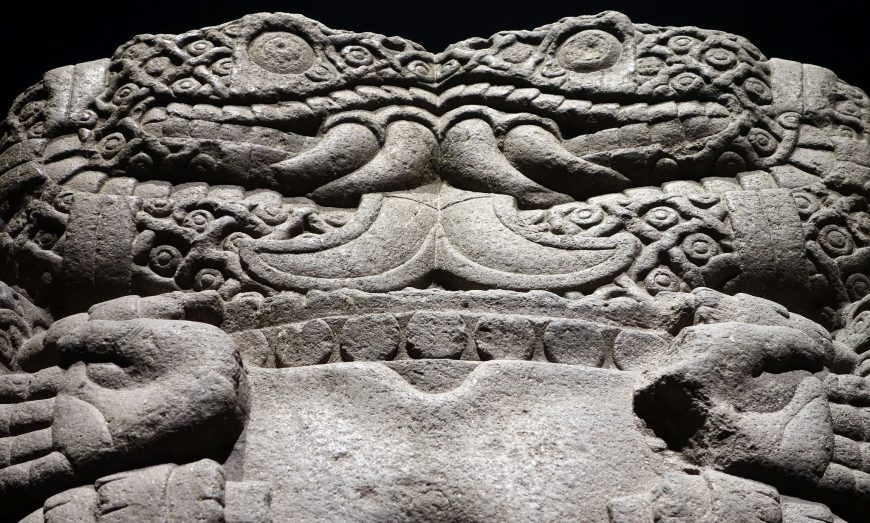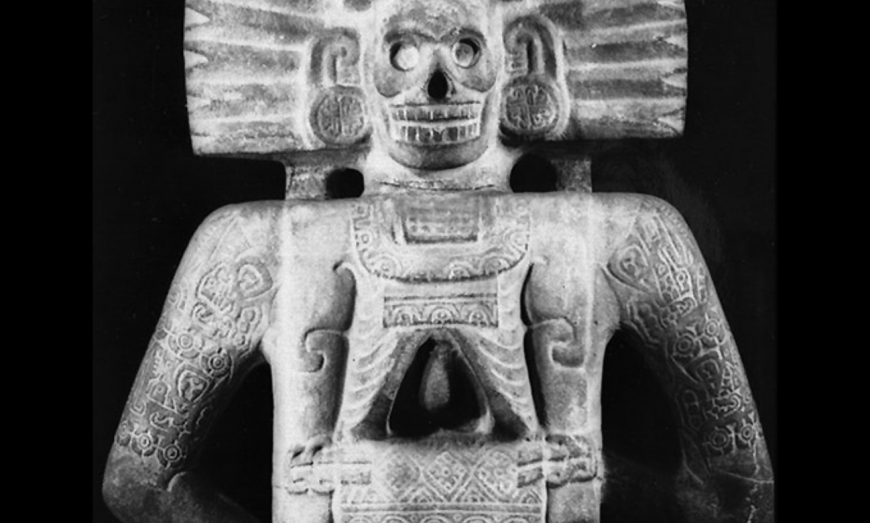Mexica brazier of Chicomecoatl, c. 1500, ceramic, found in Tláhuac (south of Mexico City), 104 cm high (Museo Nacional de Antropología, Mexico City); a conversation between Dr. Lauren Kilroy-Ewbank and Dr. Steven Zucker
Brazier of Chicomecoatl
[0:00] [music]
Dr. Steven Zucker: [0:05] We’re in the National Museum of Anthropology in Mexico City, looking at one of four large ceramic braziers, vessels that were containers for burning. This one represents a goddess associated with maize, with ripe corn.
Dr. Lauren Kilroy-Ewbank: [0:21] The one we’re looking at is Chicomecoatl, or “Seven Serpent.” She is a very popular deity in the Aztec, or Mexica, pantheon. We see her not only in ceramic, but also in stone sculpture.
Dr. Zucker: [0:34] The association with maize is immediate. We can see that she’s framing her face with four ears of corn. This is such a wonderfully dense sculpture.
Dr. Kilroy-Ewbank: [0:41] Beyond holding the ears of corn, which I should note are red and dark blue or black, making reference to the different type[s] of maize, we see her face here behind the corn, her eyes painted, looking out at us, her mouth open, with these large earspools, and then framed by this fantastic and very elaborate headdress.
Dr. Zucker: [1:00] We know that costume was tremendously important for the Aztecs, and this is a great example of it. We can see, for instance, four circles that would in physical costume have been pleated paper.
Dr. Kilroy-Ewbank: [1:11] Exactly. While all this is in ceramic, it’s referencing the types of ritual regalia that would have been used.
Dr. Zucker: [1:17] This is exceptional, because we have so much of the polychromy — that is, of the paint, of the color — that still survives. We can see reds and blues and whites and blacks.
Dr. Kilroy-Ewbank: [1:25] Which are some of the primary colors that you see in Aztec art. What’s wonderful here is not only that we have this elaborate headdress fairly intact, but also the rest of her costume, like her skirt, in this very rectangular block-like construction, much of the polychromy still exists, where we have these red bands.
Dr. Zucker: [1:43] It reminds me of architecture. It seems as if the headdress is so elaborate, it is as if she’s wearing a building.
Dr. Kilroy-Ewbank: [1:49] They’re almost obscuring or really downplaying the face.
Dr. Zucker: [1:52] Although the face is so present, she’s coming out at us with a kind of intensity that captures my attention.
Dr. Kilroy-Ewbank: [1:58] This particular face would have emphasized this experience that one would have if you were to walk into a temple and to see an object like this that’s emitting burning materials in its body.
Dr. Zucker: [2:10] The smoke would be rising up from behind this. It would have been tremendously dramatic. Corn is so central to the development of Mesoamerican culture.
Dr. Kilroy-Ewbank: [2:18] Maize is the staple food crop, and that is very true of the Aztecs as well, because we don’t only see this particular goddess — whose name again is Seven Serpent, or Chicomecoatl in Nahuatl — but we see other versions of maize deities, like Xilonen, who is the maize goddess affiliated with young corn.
[2:36] We even see corn in a variety of other objects, because as the cornerstone of the diet it also became invested with these important, sacred meanings.
Dr. Zucker: [2:45] The cobs themselves are so beautifully articulated. It reminds me of so many other sculptures by the Aztecs of other foodstuffs. In the same gallery, this marvelous representation of a squash, and corn and squash together with beans create a perfect protein.
Dr. Kilroy-Ewbank: [2:59] If we’re talking about this deity within the religious practices of the Aztecs, they had a very active ritual calendar. Many of these monthly festivals would revolve around maize deities, including Seven Serpent here.
Dr. Zucker: [3:16] It would have been on those feast days that corn would have been enjoyed.
Dr. Kilroy-Ewbank: [3:19] There would have been special tamales distributed to people to be eaten during these festivals as a very potent — very sensual in terms of using many different senses — reminder of the centrality of maize.
[3:31] [music]
| Title | Brazier of Chicomecoatl |
| Artist(s) | Unrecorded artist |
| Dates | c. 1500 |
| Places | North America / Mexico |
| Period, Culture, Style | Mesoamerican / Mexica (Aztec) |
| Artwork Type | Sculpture / Ceramics |
| Material | Clay |
| Technique | Polychromy |
Read about this brazier on the Google Arts and Culture project
Learn more about the Mexica (Aztecs) on Smarthistory
Aztec Empire from the Solomon R. Guggenheim Museum
Read about the Head of Xilonen at the Art Institute of Chicago, which also includes an educational resource about this sculpture
Terms and key ideas
- Mexica (or Aztec) ceramic art
- braziers and marking offerings to deities
- Chicomecoatl and Xilonen as deities
- the importance of maize in Mexica culture
- the concept of the deity impersonator


